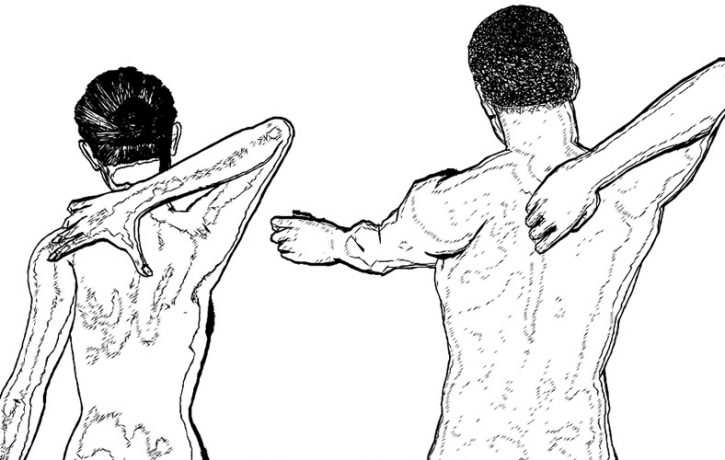in Joints & Muscles, Sports Injury
The Rotator Cuff – What Exactly Does That Mean?

The rotator cuff is found in your shoulder, and is a combination of a group of muscles that stabilise, and move your shoulder in different directions. When a doctor or other medical professional says to you that you’ve damaged your rotator cuff, it’s a generic term meaning you’ve strained a muscle in your shoulder. Further investigation will lead the diagnosis a little more detailed into what exactly has been damaged, so it can be targeted in rehab a little better.
What is the rotator cuff made of?
The rotator cuff consists of 4 muscles all based around our scapula (or shoulder blade) and in some way attach themselves from the scapula over to the Humerus (your arm bone). The muscles are called Subscapularis, Teres minor, Supraspinatus and Infraspinatus. More than likely another reason for the term “rotator cuff” is because the individual muscle names are such a mouthful! The way in which these 4 muscles attach to the Humerus is shaped like a cuff, wrapped around the superior head of the bone. Another possible origin of its name.
Teres minor would have you presume there is a major, which is true, however it’s not a part of the rotator cuff group. This is because the Teres major muscle has a lower attachment point down the Humerus as opposed to the rest of the muscles which attach close to the glenohumeral joint, where your arm meets your torso. It’s a small difference however it completely changes the purpose of the muscle.
What does the rotator cuff do?
Each muscle has a slightly different role to play in movement; Subscapularis for example helps to abduct your arm, raising it over your head. This is the muscle most susceptible to injury for the average gym goer as the muscle runs through a small gap between bones known as the subacromial space. It can become inflamed or irritated if excessive abduction is performed, or if not warmed up effectively, and eventually causing impingement syndrome.
The infraspinatus can be quite tender when treated, but this is because it’s one of the easiest to palpate, and sits directly on top of the lower part of the scapula. This means when massaging the muscle, the therapist will be squeezing the infraspinatus between their hand and your shoulder blade. It’s all in good hands however, a trained professional will be fully aware of this fact and will know how much pressure is beneficial to you. The infraspinatus action is to laterally rotate the arm. An example of that use would be swimming and performing a breast stroke. The infraspinatus will aid in pulling your arm out to the side. The Teres minor personally I’ve always found a little odd. It pairs up with infraspinatus functionally, yet it is named with the Teres major. Perhaps because of the discoverer, or the way they both match up in size.
The Subscapularis muscle is much harder to reach, as it sits between your scapula and your ribs, this means for the therapist to have any palpation they will need to go under your shoulder blade. Luckily enough it rarely becomes irritated or injured. The primary sport that may affect it is boxing as the subscapularis function is to medially rotate the Humerus, contrasted with the infraspinatus. As a boxer performs most types of punches, the subscapularis will be doing a lot of work.
In simpler terms, the rotator cuff muscle group help in twisting your shoulder around and lifting over your head. They also supply stabilization for the shoulder itself, to prevent any dislocation. This won’t stop it completely however, as the shoulder is one of the weakest joints in your body, Structurally if you imagined putting a tennis ball on the top of a baseball bat, then turning it onto its side, that’s what the shoulder (glenohumeral joint) looks like. Other joints have a sort of slot to sit into, but the arm does not have that. It heavily relies on ligaments, muscles and other structures to hold it in place.
Injuries to be aware of
So we’ve already mentioned Impingement syndrome, which is probably the most common to see in the clinic involving the rotator cuff. Other less common injuries are:
- Subacromial bursitis – A bursa’s purpose is to prevent any impact to an area. This bursa sits between a rotator cuff muscle and a bony prominence stemming from your shoulder blade. If there is too much pressure, the bursa will become inflamed.
- Rotator cuff tendinitis/tear – Just as with every muscle in your body, the rotator cuff muscles are vulnerable to muscle strains or tendon inflammation. Repetitive use or excessive loading can cause these problems to occur.
- Frozen shoulder – This is not necessarily directly related to the rotator cuff muscles, but they will certainly play a role in the condition. If you feel limited in any range of movement not so much because of muscle, but a pain deep in your shoulder that feels abnormal, see your GP or contact a qualified professional.
This article was written by Kieran Mote Sports Therapist BSc.
For more information, or to book an appointment with a sports physiotherapist, please call The Body Matters on 01702 714968.
- How to See Life from Another Person’s Point of View - 22nd April 2024
- Using Self-Talk to Boost Self-Confidence - 5th April 2024
- Simple Techniques for Recharging Amid a Hectic Schedule - 28th March 2024
